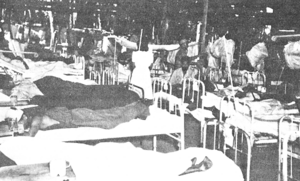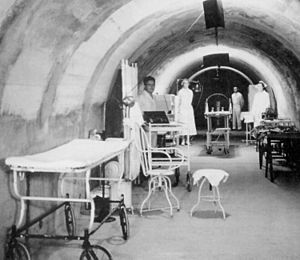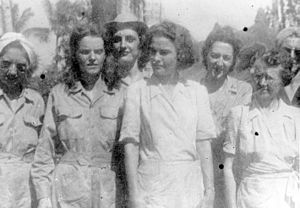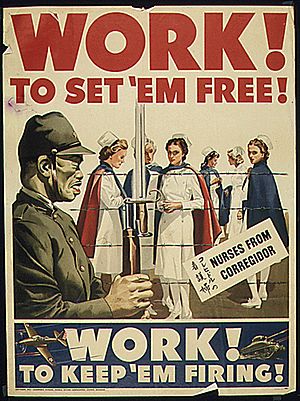Angels of Bataan facts for kids
Quick facts for kids Angels of Bataan and Corregidor |
|
|---|---|
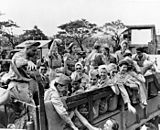 
Liberated nurses, February 12, 1945
|
|
| Active | December 1941 - March 1945 |
| Country | United States |
| Allegiance | United States |
| Branch | United States Army, United States Navy |
| Type | Nurse corps |
| Size | 78 nurses |
| Nickname(s) | Battling Belles of Bataan |
| Engagements | Battle of Bataan Battle of Corregidor World War II Philippines Campaign |
| Commanders | |
| Notable commanders |
Capt. Maude C. Davison (US Army), Lt. Laura M. Cobb (US Navy) |
The Angels of Bataan were brave nurses from the U.S. Army and U.S. Navy. They were working in the Philippines when World War II started in the Pacific. They helped soldiers during the Battle of the Philippines in 1941-1942.
When the areas of Bataan and Corregidor were taken over, 11 navy nurses, 66 army nurses, and 1 nurse-anesthetist were captured. They became prisoners of war (POWs) near Manila. Even as prisoners, they kept working as nurses. After a very difficult time, they were finally set free in February 1945. They were also known as the "Angels of Bataan and Corregidor" or "The Battling Belles of Bataan."
Contents
Nurses in Manila
At the start of World War II, U.S. Army and Navy nurses worked at Sternberg General Hospital in Manila. They also worked at other military hospitals nearby.
In late December 1941, 88 U.S. Army nurses left Manila for Corregidor and Bataan. Two army nurses, Lt. Floramund A. Fellmeth and Lt. Florence MacDonald, went with injured patients. They sailed on a hospital ship called the Mactan to Australia.
The navy nurses, led by Lt. Laura M. Cobb, stayed in Manila. They helped patients during the first invasion. One navy nurse, Ann A. Bernatitus, escaped to Bataan just before Manila was captured. The other 11 navy nurses were captured when Manila fell. They were held by the Japanese at Santo Tomas.
The army nurses, led by Capt. Maude Davison and 2nd Lt. Josephine Nesbit, escaped Manila. Nurse Bernatitus joined them. They went on to serve during the Battle of Bataan and the Battle of Corregidor.
Serving on Bataan
In late December 1941, many nurses were sent to two battlefield hospitals on Bataan. These were called Hospital #1 and Hospital #2. These hospitals were the first in U.S. history to have open-air wards since the Civil War. Many patients and staff got tropical diseases, like malaria and dysentery.
Before Bataan was captured on April 9, 1942, the nurses there were ordered to Corregidor. This order came from General Wainwright. He was the commander of U.S. forces in the Philippines after General Douglas MacArthur left for Australia.
Life on Corregidor
During the Battle of Corregidor, the nurses worked in the hospital. This hospital was inside the Malinta Tunnel system.
Escaping the Island
On April 29, a small group of army nurses left Corregidor. They were evacuated on a navy PBY Catalina plane. However, they got stuck on Mindanao and became prisoners. They were later moved to Manila and held at the University of Santo Tomas. On May 3, the only navy nurse, Ann A. Bernatitus, and a few more army nurses escaped. They left on a submarine called the Spearfish.
Corregidor Falls
When Corregidor was taken by Japanese forces on May 6, the remaining nurses were captured. On July 2, they were moved to the Santo Tomas Internment Camp.
Being Prisoners of War
At Santo Tomas Camp
The University of Santo Tomas campus became the Santo Tomas Internment Camp. The Japanese used it during their time in the Philippines. This camp held both civilians and the captured army and navy nurses. The army nurses stayed there until they were set free.
Capt. Maude C. Davison, who was 57 years old, took charge of the nurses. She made sure they kept a regular nursing schedule. She also insisted that all nurses wear their khaki uniforms while on duty. She worked closely with Josephine Nesbit.
At Los Baños Camp
In May 1943, the navy nurses were moved to a new camp. This camp was at Los Baños. They were still led by Lt. Laura M. Cobb. There, they set up a new medical center. They continued to work as a nursing team. At Los Baños, they became known as "the sacred eleven."
News Back Home
The capture of the nurses was widely known in the U.S. But not much was known about what happened to them until they were freed.
Lt. Juanita Redmond, one of the few nurses who escaped, wrote a book in 1943. It was about her experiences on Bataan. The book ended by reminding everyone that her friends were still prisoners. The nurses' story was also shown in several movies during the war, including:
- Cry 'Havoc' (1943)
- So Proudly We Hail! (1943), which was based on Redmond's book.
- They Were Expendable (1945)
When So Proudly We Hail was in theaters, Red Cross volunteers set up booths. They were there to encourage more people to become military nurses.
Final Year of Imprisonment
In January 1944, the Japanese Army took control of the Santo Tomas Internment Camp. Food became very scarce. By November 1944, each person got only 960 calories per day. By January 1945, this was cut even more, to 700 calories per day.
A study in 2002 found that the nurses lost a lot of weight. On average, they lost 30% of their body weight. They also had health problems similar to male POWs from the Pacific. Maude C. Davison's weight dropped from 156 pounds to 80 pounds.
Freedom at Last
General Douglas MacArthur ordered a daring raid on Santo Tomas. This was part of the Battle of Manila. The prisoners at Santo Tomas, including the nurses, were freed on February 3, 1945. A group from the 1st Cavalry rescued them.
The navy nurses were later freed in the Raid at Los Baños.
When they returned to the U.S., the Army nurses received awards. These included the Bronze Star for bravery. They also received a Presidential Unit Citation for their amazing heroism. The navy nurses also received Bronze Stars.
-
Maj. Maude Davison and Lt. Eunice Young at the Presidio
Remembering Their Bravery
On April 9, 1980, a bronze plaque was placed at the Mount Samat shrine. It was dedicated by men who survived Bataan and Corregidor. It says:
To the Angels In honor of the valiant American military women who gave so much of themselves in the early days of World War II. They provided care and comfort to the gallant defenders of Bataan and Corregidor. They lived on a starvation diet, shared the bombing, strafing, sniping, sickness and disease while working endless hours of heartbreaking duty. These nurses always had a smile, a tender touch and a kind word for their patients. They truly earned the name"The Angels of Bataan and Corregidor"
Maj. Maude C. Davison was given the Distinguished Service Medal in 2001. Many believe she kept the army nurses alive by making them keep their identity as nurses. A similar award has not yet been given to Chief Nurse Laura M. Cobb.
Nancy Belle Norton, a grandmother known as "the Angel of Bataan," received the Medal of Freedom in 1945.
Why They Are Important
- They were the first large group of American women in combat.
- They were the largest group of American women captured and held prisoner by an enemy.
- During World War II, their story was used to encourage factory workers to produce more.
- Their story also helped get more military nurses to join up. By the end of the war, over 59,000 army nurses volunteered. More than half served in war zones, and sixteen were killed.
- By the 1980s, the "Angels of Bataan and Corregidor" were seen as a great example for Army Nursing.



